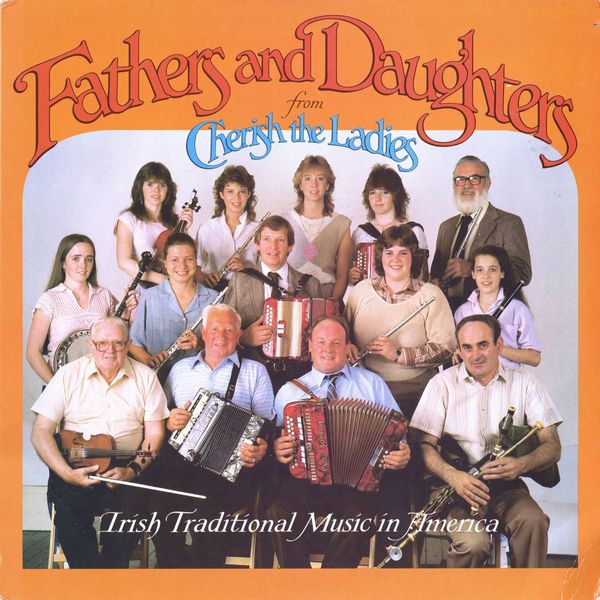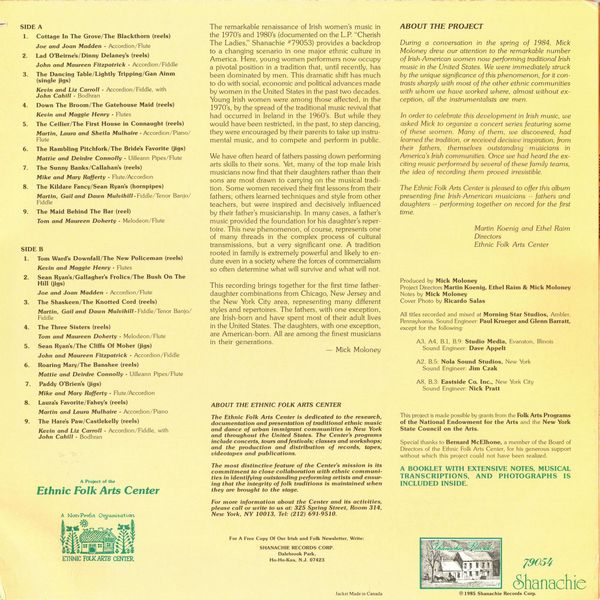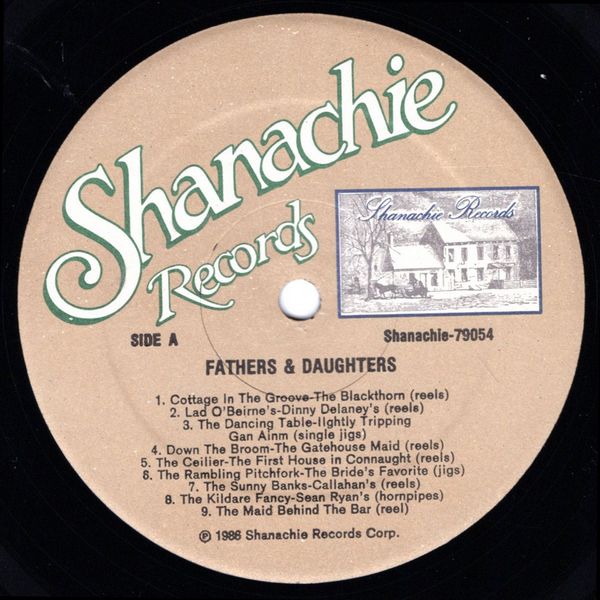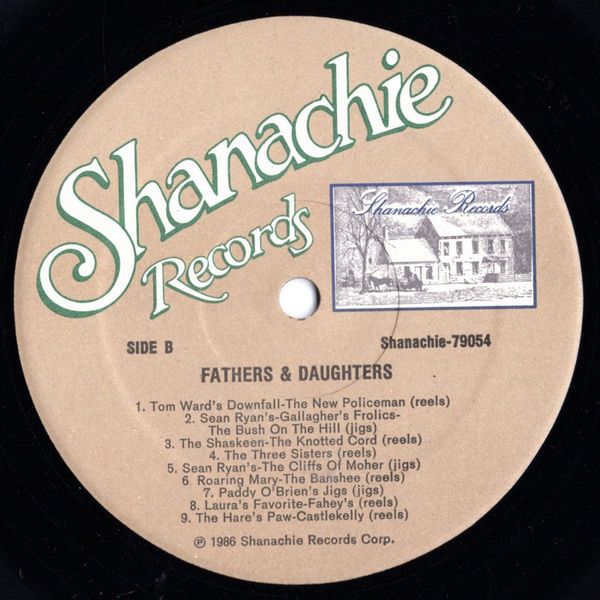Cherish the Ladies • Fathers and Daughter — Irish Traditional Music in America
- Fathers and Daughter — Irish Traditional Music in America
- 1985 - Shanachie 79054 LP (USA)
- Side One
- Cottage In the Grove & The Blackthorn (reels) — Joe and Joan Madden – Accordion & Flute
- Lad O'Beirne's & Dinny Delaney's (reels) — John and Maureen Fitzpatrick – Accordion & Fiddle
- The Dancing Table, Lightly Tripping & Gan Ainm (single jigs) — Kevin and Liz Carroll – Accordion & Fiddle, with John Cahill – Bodhrán
- Down The Broom & The Gatehouse Maid (reels) — Kevin and Maggie Henry – Flutes
- The Ceilier & The First House in Connaught (reels) — Martin, Laura and Sheila Mulhaire – Accordion, Piano & Flute
- The Rambling Pitchfork & The Bride's Favorite (jigs) Mattie and Deirdre Connolly – Uilleann Pipes & Flute —
- The Sunny Banks & Callahan's (reels) —
Mike and Mary Rafferty – Flute & Accordion
- The Kildare Fancy & Seán Ryan's (hornpipes) — Martin, Gail and Dawn Mulvihill- Fiddle, Tenor Banjo & Fiddle
- The Maid Behind the Bar (reel) — Tom and Maureen Doherty – Melodeon & Flute
- Side Two
- Tom Ward's Downfall & The New Policeman (reels) Kevin and Maggie Henry – Flutes —
- Seán Ryan's, Gallagher's Frolics & The Bush on The Hill (jigs) — Joe and Joan Madden – Accordion & Flute
- The Shaskeen & The Knotted Cord (reels) — Martin, Gail and Dawn Mulvihill- Fiddle, Tenor Banjo & Fiddle
- The Three Sisters (reels) — Tom and Maureen Doherty – Melodeon & Flute
- Seán Ryan's & The Cliffs of Moher (jigs) — John and Maureen Fitzpatrick – Accordion & Fiddle
- Roaring Mary & The Banshee (reels) — Mattie and Deirdre Connolly – Uilleann Pipes & Flute
- Paddy O'Brien's (jigs) — Mike and Mary Rafferty – Flute & Accordion
- Laura's Favorite & Fahey's (reels) — Martin and Laura Mulhaire – Accordion & Piano
- The Hare's Paw & Castlekelly (reels) — Kevin and Liz Carroll – Accordion & Fiddle, with John Cahill – Bodhrán
- Musicians
- John Cahill: Bodhrán
- Kevin Carroll: Accordion
- Liz Carroll : Fiddle
- Dierdre Connolly: Flute
- Mattie Connolly: Uillean Pipes
- Maureen Doherty: Flute
- Tom Doherty: Melodeon
- John Fitzpatrick: Accordion
- Maureen Fitzpatrick: Fiddle
- Kevin Henry: Flute
- Maggie Henry: Flute
- Joan Madden: Flute
- Joe Madden: Accordion
- Dawn Mulvihill: Fiddle
- Gail Mulvihill: Tenor Banjo
- Martin Mulvihill: Fiddle
- Laura Mulhaire: Piano
- Martin Mulhaire: Accordion
- Sheila Mulhaire: Flute
- Mary Rafferty: Accordion
- Mike Rafferty: Flute
- Credits
- Produced by Mick Moloney
- Project Directors: Martin Koenig, Ethel Raim & Mick Moloney
- Cover Photo: Ricardo Salas
- All titles recorded and mixed at Morning Star Studios, Ambler, Pennsylvania
- Sound Engineer: Paul Krueger and Glenn Barratt, except for the following:
- Tracks: 3, 4, 10 & 18 — Recorded at Studio Media, Evanston, Illinois
- Sound Engineer: Dave Appelt
- Tracks: 2 & 14 — Recorded at Nola Sound Studios, New York
- Tracks: 8 & 11 — Recorded at Eastside Co, Inc., New York City
- Sound Engineer: Nick Pratt
- A Project of the Ethnic Folk Arts Center
- This project is made possible by grants from the Folk Arts Programs of the National Endowment for the Arts and the New York State Council on the Arts.
- Special thanks to Bernard McElhone, a member of the Board of Directors of the Ethnic Folk Arts Center, for his generous support without which this project could not have been realized.
Sleeve Notes
The remarkable renaissance of Irish women's music in the 1970's and 1980's (documented on the L.P. "Cherish The Ladies," Shanachie #79053) provides a backdrop to a changing scenario in one major ethnic culture in America. Here, young women performers now occupy a pivotal position in a tradition that, until recently, has been dominated by men. This dramatic shift has much to do with social, economic and political advances made by women in the United States in the past two decades. Young Irish women were among those affected, in the 1970's, by the spread of the traditional music revival that had occurred in Ireland in the 1960's. But while they would have been restricted, in the past, to step dancing, they were encouraged by their parents to take up instrumental music, and to compete and perform in public.
We have often heard of fathers passing down performing arts skills to their sons. Yet, many of the top male Irish musicians now find that their daughters rather than their sons are most drawn to carrying on the musical tradition. Some women received their first lessons from their fathers; others learned techniques and style from other teachers, but were inspired and decisively influenced by their father's musicianship. In many cases, a father's music provided the foundation for his daughter's repertoire. This new phenomenon, of course, represents one of many threads in the complex process of cultural transmissions, but a very significant one. A tradition rooted in family is extremely powerful and likely to endure even in a society where the forces of commercialism so often determine what will survive and what will not.
This recording brings together for the first time father-daughter combinations from Chicago, New Jersey and the New York City area, representing many different styles and repertoires. The fathers, with one exception, are Irish-born and have spent most of their adult lives in the United States. The daughters, with one exception, are American-born. All are among the finest musicians in their generations.
Mick Moloney
About the Project
During a conversation in the spring of 1984, Mick Moloney drew our attention to the remarkable number of Irish-American women now performing traditional Irish music in the United States. We were immediately struck by the unique significance of this phenomenon, for it contrasts sharply with most of the other ethnic communities with whom we have worked where, almost without exception, all the instrumentalists are men.
In order to celebrate this development in Irish music, we asked Mick to organize a concert series featuring some of these women. Many of them, we discovered, had learned the tradition, or received decisive inspiration, from their fathers, themselves outstanding musicians in Americas Irish communities. Once we had heard the exciting music performed by several of these family teams, the idea of recording them proved irresistible.
The Ethnic Folk Arts Center is pleased to offer this album presenting fine Irish-American musicians — athers and daughters — performing together on record for the first time.
Martin Koenig and Ethel Raim
Directors — Ethnic Folk Arts Center




